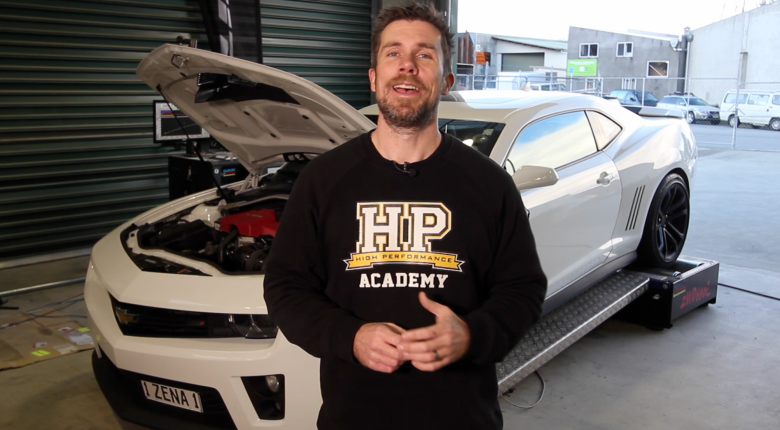If you find your GM vehicle goes excessively rich after being reflashed, we’ve got some good news - Now there a fix! In this video we’ll demonstrate the problem, show you why it happens, and show you the fix that HP Tuners have just released.
Are you having problems with the air fuel ratio going rich after a reflashing when tuning GM vehicles on the HP tuners platform? Well, if you are, I'm here to tell you there's a fix. Let's jump in the car and check it out. The rich after reflash issue is common on a number of GM vehicles, and here I'm using a 2013 ZL1 Camaro to demonstrate the problem. I've got my VCM scanner running and the engine or PCM has just been reflashed. Everything is up to operating temperature. Let's start it, and see what happens.
In particular, what we're looking for here is our commanded lambda verses our measured lambda. You can see in green our commanded lambda is sitting at 1.0. However, immediately after the reflash our measured lambda is sitting right about ten to twelve percent richer than our target. This is the problem with the rich after reflash situation. You can see that our measured lambda moving back towards our target but the reason for that is that our short term and long term fuel trims have now kicked in, and you can see that our long term fuel trims are currently sitting at negative fifteen percent in order to get us back to our target lambda.
This is the rich after reflash problem and traditionally the way of getting around this has been to give the engine 15 to 20 minutes of idling. What we'll see over that time is that our trims will come back towards zero, and will end up with our measured air fuel ratio matching our target. Obviously that's an incredibly time-consuming process, but as I mentioned there is now a fix for it. Before we go over the fix, I'm going to talk about what actually causes the problem. It is always nice to know what's actually happening in the background.
Let's have a look, first of all, on our scanner. We can see that I'm scanning a parameter called injector tip temperature. Right now, you can see that this is sitting at eighty-one degrees centigrade. Let's go back to our VCM editor and we'll see why this injector tip temperature parameter is important. If we go to our fuel general tab in the VCM editor software, you can see under injector tip temperature control, we had a table called, 'Off set verses and injector tip temperature'. If we open up this table we can see we have a two-dimensional table relatively to injector tip temperature. The important point is that up to about forty-five degrees centigrade, this table is filled with zeros. Essentially, it's having no effect. However, once we get up to the higher temperatures, particularly in the eighty to ninety-five degree range, which we are quite likely to see their engine hot. We can see that the numbers are significantly more positive, what this does is that it adds to the inject of off-set value, which essentially holds the injector open longer, delivering more fuel and resulting in our rich after reflash situation.
The problem is, under normal operating conditions we're unlikely to see our injector tip temperature reach these sort of ranges. There's no sensor for and instead, the PC calculates this temperature. After I reflashed the PC, certain areas inside the memory of the PC are reset. Factors such as injector tip temperature have to be relearned from scratch. When the engines at a hot operating temperature and we reflash the PC, the injector tip temperature defaults to the current engine coolant temperature. Once the engine's running, the PC's algorithm then relearns the injector tip temperature and we'll say that the injector tip temperature over time starts moving back down to a more reasonable value.
At normal running conditions we can expect our injector tip temperature to be sitting in the range of perhaps forty, forty-five degrees centigrade. As we can see from the table, in this range, we're having no effect from this table. The fix for this, to get around our rich after reflash problem is simply to highlight this entire table, and set all of the values to zero. Once we've done this, we can now reflash our PC and let's do that and have a look at the results in the scanner.
With our flash complete, let's restart the engine and we'll see the difference. Straight away, you can see that if you're ratio is almost right on target, even though you can see at the moment, our closed loop trims are still sitting at zero. We don't have any problem with the engine in the initially going excessively rich. Note that the injector tip temperature is still sitting at eighty degrees centigrade, which as we can see matches our currently engine-coolant temperature. As you can see, zero in the offset verses of the injector tip temperature reverses that rich after reflash problem. This can literally save hours of wasted downer time, and we need to thank the HP tuners forum who found this table, as well as the HP tuner's engineers for incorporating it so quickly. If you can't see the offset verses injector tip temperature table in your version of VCM Editor, make sure you update to the latest version as soon as possible.
If you want to learn more about reflashing GM vehicles using the HP Tuner's software, then check out the practical reflash tuning course. It's an online course that you can take from the comfort of your own home. Click the link for more details!







Comments
No one has commented on this page yet.